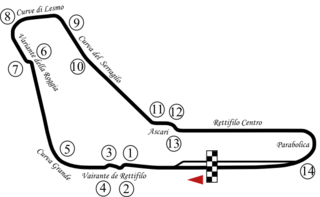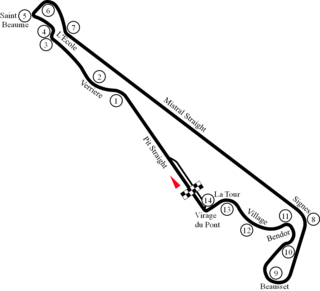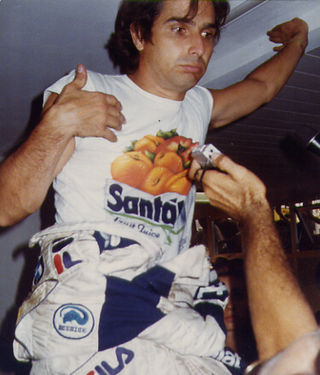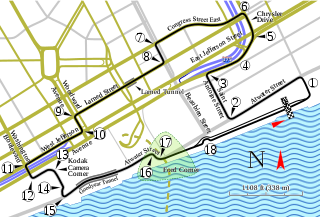Summary
The street circuit used for this Grand Prix laid out in the center of Detroit had been modified a little- the inside wall at the left-right sequence of corners on Beaubien Street between Congress Street and the notoriously bumpy Larned Street had been moved closer to the street itself, which made the right hander transitioning between Beaubien and Larned Streets slower than before. A bridge connecting 2 buildings flanking Larned Street had also been built; which actually hid the worst bumps on Larned from camera view- although these bumps were made obvious to viewers by the car's undertrays creating sparks thanks to the cars bouncing over these bumps rather violently.
In Friday qualifying, Senna's nimble Lotus, well suited to the track, and combined with Senna’s raw talent was easily quickest in both sessions, averaging 88.183 mph (141.917 km/h), nearly 1.2 seconds clear of Nigel Mansell's Williams. Still, changes to the course meant that Senna's time was over a second slower than Nelson Piquet's pole-winning time from the previous year. The Ferraris of Alboreto and Johansson were in third and ninth place, as Alboreto said, "Our suspension does not absorb the bumps nearly as well as the Lotus. I have trouble getting the power down, which is necessary between the slow corners." Rain on Saturday meant that the Friday times would determine the grid, and the teams would be without a much-needed second day of practice although Gerhard Berger had to set his qualifying time on the Saturday as he didn't set a time on Friday after crashing twice before he could set a time.
The Williams teammates used different tyre compounds in qualifying and were over a second apart on the grid. Rosberg, on qualifiers, was fifth, while Mansell chose the softer race compound and placed second. This revelation led Rosberg to gamble on using the soft race rubber for the race, while everyone else had the harder compound. Aided by a cool breeze on Sunday, this decision played an important role in the race's outcome.
Sunday was warm, humid, clear and breezy with a large and enthusiastic crowd. Unlike the 1984 race, the drivers made a clean start, as Mansell got away well on the outside and took the first corner ahead of Senna. In Turn 2, however, Senna took the lead back, and by the end of the first lap, Rosberg had also gotten around Mansell. After one lap, Senna and Rosberg were opening a gap to Mansell, Prost, Alboreto, Derek Warwick, Elio de Angelis, Johansson, Piquet and Lauda. The Tyrrells of Bellof and Martin Brundle, down on power to the turbos but always extremely well suited to the tight Detroit circuit, each moved up six places on the first lap to 12th and 13th.
But as the race went on, the track was already beginning to break up, with the worst break up at Turn 2. By lap seven, Senna and Rosberg led Mansell by seven seconds. On lap eight, Senna surrendered the lead when he pitted for tires; regretting his gamble to try to run much of the race on one set of tires, relying on his car's superior performance to all of the other cars. Warwick had dropped back steadily, eventually retiring with a broken driveshaft, while the McLarens of Prost and Lauda quickly experienced brake problems. Lauda made it back to the pits to retire with no brakes on lap 10, but when Prost had the same problem on lap 20, he was unable to slow for Turn 2 and slid into the tyre wall.
De Angelis, on the other hand, was making steady progress. He took fourth when Senna pitted, then passed Alboreto for third and began closing the gap to Mansell, who also was struggling with overheating brakes. On lap 20, with Rosberg's lead at 24 seconds, de Angelis got around Mansell to take second place. Mansell pitted on lap 24 after losing another position to Johansson. He returned in ninth place only to retire immediately when he hit the wall hard in Turn 2.
As he was about to be lapped, Gerhard Berger damaged the nose of de Angelis' Lotus when he closed the door on the Italian. When de Angelis pitted for tires and a new nose, the Tyrrells were nose to tail in fourth and fifth, hounding the Ferrari of Alboreto. Approaching Turn 16 on lap 31, Philippe Alliot moved over to let Alboreto through but didn't see Brundle right behind. When Alliot moved back to the racing line, Brundle had nowhere to go and hit the wall in a shower of sparks.
At the halfway point, Rosberg led Johansson by 33 seconds. Alboreto was another 10 seconds back, followed by Bellof, Senna and de Angelis. Several successive fastest laps by Senna allowed him to overtake Bellof and then quickly close the gap to Alboreto.
Entering Turn 2, where the surface was beginning to break up and where both Prost and Mansell had crashed, Alboreto stayed right, away from the racing line and the bad patch at the apex. Senna charged through on the left, got on the marbles, and hit the wall exactly as the others had done, while Alboreto continued, minus the threat to his third place. Meanwhile, Rosberg, secure in the lead, had noticed his water temperature climbing. When a member of the crew noticed something caught in his radiator, he pitted to have it removed. The crew also gave him new tyres, which he didn't want because Johansson was not far behind. Rosberg blasted out of the pits and just managed to beat the Ferrari to the first corner. Spurred on by the chance for his first win, Johansson hounded the Williams until, with just three laps to go, a brake disc broke up and he began to crawl around the circuit, hoping to make the finish.
Alboreto, in third, had also been trying to save his brakes, but he now had to contend with a charging Bellof. With two laps to go, the West German had the Tyrrell right on Alboreto's tail, waiting for a mistake. Just as he was about to go by, however, Bellof's clutch began slipping, and he had to be content to follow the Ferrari home, scoring the last points for Ford-Cosworth DFV engine in Formula One. De Angelis, the last driver on the lead lap took fifth place, and Piquet brought the Brabham home in sixth.















